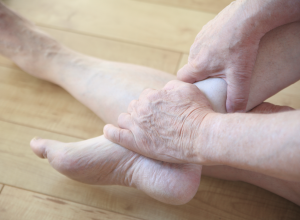
Critical Limb Ischemia
Critical limb ischemia (CLI), sometimes called limb threat, is an advanced stage of peripheral artery disease characterized by a severe obstruction of the arteries that reduces blood flow to the extremities (hands, arms, feet and legs).
Symptoms
Critical limb ischemia typically manifests in the form of rest pain (limb pain even while resting), ulcers on and around the ankles that are caused by lack of blood supply and gangrene, which is tissue death.
Rest pain is characterized by a burning pain in the feet or legs that doesn’t go away. It is generally thought to be much worse than muscle pain associated with exercise and other physical activity (intermittent claudication) and can keep patients up at night.
Other symptoms may include a noticeable decrease in temperature of the affected limb, smooth and shiny skin, a thickening of the toenails and an absent or reduced pulse in the legs or feet.
Causes
CLI is a symptom of advanced peripheral arterial disease (PAD), which results from a narrowing or clogging of arteries that causes a reduction in blood flow to the body’s limbs.
Risk factors for critical limb ischemia include smoking, diabetes, obesity, sedentary lifestyle, high cholesterol, high blood pressure and a family history of vascular disease. Furthermore, men over the age of 60 and women who have already experienced menopause are at a higher risk than other patients at developing CLI.
Treatment
CLI is a critical condition that will not improve on its own and requires immediate comprehensive treatment by a vascular specialist. Treatment of critical limb ischemia typically involves revascularization (reintroducing blood supply) via angioplasty or vascular bypass. When tissue loss is present, wound debridement may be necessary.
In addition to endovascular treatments and/or arterial surgery, doctors may recommend medications that slow the progression of the disease and treat risk factors like diabetes, high cholesterol and high blood pressure.
According to the Journal of Vascular Surgery, critical limb ischemia typically has a negative prognosis within a year after initial diagnosis. About 12 percent of patients experience amputation after one year, and mortality rates stand at 50 percent of patients five years after diagnosis and 70 percent of patients 10 years after diagnosis. VascularCures.org reports that 25 percent of patients who develop CLI require amputation of the toes, part of the foot or leg.
Notice concerning medical entries:
Articles having medical content shall serve exclusively for the purpose of general information. Such articles are not suitable for any (self-) diagnosis and treatment of individual illnesses and medical indications. In particular, they cannot substitute for the examination, advice, or treatment by a licensed physician or pharmacist. No replies to any individual questions shall be effected through the articles.






